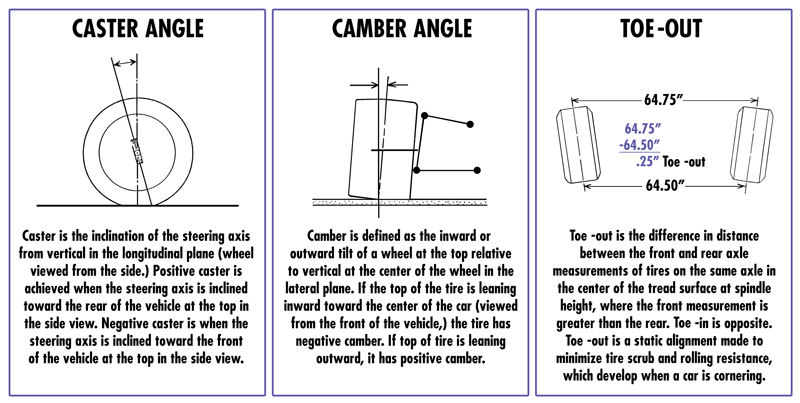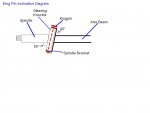While Eastcoast provided some good info, and Devino too, I feel the Ackermann didn't get covered well enough for our purposes. In my own words-
As a four-wheeled vehicle travels through a curve, the tire on the inside of the curve follows a shorter path than the tire on the outside of the curve. This creates two needs-
1)the outside tire must turn faster than the inside tire. As our karts are typically rear wheel drive, let's suffice to say that since the front tires are freewheeling, this solves itself.
2)The inside tire must turn more (tighter, by a few degrees). If the tires always remain parallel to each other, this creates a scrubbing condition. Usually, the weight is thrown to the outside tire, so the inside tire actually scrubs sideways a bit thru the curve. This causes accelerated tire wear and poor handling. To correct this, we apply the Ackermann principle, so named after the fella that figured it out. Mr Ackermann determined that the tires must turn varying degrees as outlined above. Applying this principle as required for our purposes is quite easy.
Measure and mark dead centre on your rear axle, based on the contact patches of the rear tires. If your chassis is offset, or your wheels aren't at exactly the same spacing on both sides, don't use the frame for your measurement.
Now, move to the front of your kart, and locate your kingpins. These are the large bolts that your front spindles swivel on when you steer. Run a string from the kingpin centre to the rear axle centre. Repeat for the other side. Now- here's the trick- When you're setting up the steering arms (the tabs that your tie rods connect to on the spindles), all you have to do is make sure that when you drill the hole into the steering arm for the rod end, that hole MUST be centred somewhere along that string.
If you already have steering arms on your spindles and the rod end hole does not intersect with the string, simply cut the arm off and re-weld at the appropriate angle.
For karts that have forward-pointing arms, the same applies, only that you have to "extend" the string forward. When you're done, instead of the arms ending up slightly angled inward toward the framerails, they will be slightly angled out.
One last point- for the above geometry to hold true in practise, your tie rods should me more or less parallel with each other, and perpendicular (at right angles) to your framerails. Hope I've cleared this up for you.




